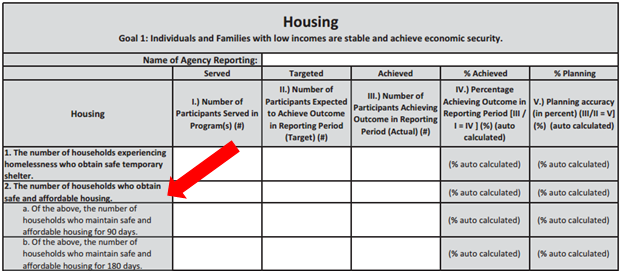OCS and NASCSP are in the process of reviewing the comments submitted during the 60-day comment period and are looking forward to incorporating suggestions into the CSBG Annual Report. During the comment period many good questions were raised about ROMA Next Generation (NG) and the CSBG Annual Report. We have compiled the most frequently asked questions will cover these questions in three separate blog posts. Yesterday’s post covered Part 1: General Questions. Click here to take a look. Today we move forward and focus on the questions regarding Module 4: Individual and Family Level.
Module 4: Individual & Family Level Questions
1. I am not able to add my WIC participants in to my agency database? Do I have to report on all my participants in the two Individuals and Households Characteristic Reports?
During the Initial Feedback Period on the CSBG Annual Report, a lot of comments expressed concern around challenges with agency data systems. Agencies may use multiple data systems that do not have an electronic data interchange or the capability to share data, creating a barrier to providing an unduplicated number of individuals and households served across programs. With this in mind, new data points were added to the Individuals and Households Characteristics reports. As shown in the graphic below, agencies can report the estimated number of individuals and families who were not included in the report, as well as the related programs.

2. For the purposes of completing the New Individuals and Households Characteristic Report, what is the definition of a “new” participant?
The purpose of the New Characteristic Report is to have a clearer understanding of the characteristics of individuals and families who are seeking services from a CAA before they receive services – because it is expected that some of the characteristics would change as a result of the service. If a demographic profile of the individuals and families is only available at a time during a program year that matches the reporting requirements, this may not allow for a clear understanding of the characteristics of those who are seeking help. The New Characteristics Report is intended to capture information about individuals and families around the time of intake or before the participant received a service or intervention. CAAs will use their expertise to define a participant as new. For example, if a participant received services ten years ago and returns to the CAA during the current reporting period, a CAA would likely identify this person as a new participant. If an individual was a child in a family that received services in the past, and is now independent, it is likely to identify this person as a new participant. The timeframe between services and the frequency of one time services will need to be taken into account in order to determine a participant as new and as such, OCS welcomes comments on an appropriate definition for a new participant.
3. What is the difference between the New Individuals and Households Characteristics Report and the All Characteristics Report? Should the All Characteristics Report include the participants reported in the New Individuals and Households Characteristics Report?
The purpose of the New Individuals and Households Characteristics Report is to provide a snapshot of participants who enter CAA services for the first time within a reporting year. The data from the New Characteristics Report will not be used to compare an individual’s or household’s change in situation or demographic information overtime, but rather is intended to provide agencies, states, and OCS with a stronger understanding of the participants who enter CAA services within a reporting year, prior to achieving outcomes as a result of receiving services. By collecting demographic information on new participants in a separate report, there will be better analysis—at the local, state, and national levels— regarding some of these questions: Who is in need of services? What does poverty look like? What has changed from previous years about who is seeking service? What are the trends?
The purpose of the All Characteristics Report is to provide demographic data on all individuals and households served in the reporting period. This report includes demographic data collected in the New Individuals and Households Characteristics Report. Thus data on new participants will be entered in both the New Individuals and Households Characteristics Report and the All Characteristics Report.
4. Why and when does the CSBG Annual Report include indicators with 90 and 180 day follow-up time frames?
Tracking outcomes over time has become a common practice inside and outside of the CSBG Network. For example, the Workplace Innovation and Opportunity Act (WIOA) measures “the number and percent of employed individuals who maintained existing or new employment for at least 270 days.” Employment retention should be outlined in the program goals and services selected by the CAAs. Some programs seek to increase employment retention, when this is the goal agencies naturally track and record the results.
The time frame of 90 days is included to allow agencies with somewhat limited capacities to continue to report on this time frame. Note, these indicators would only be reported by those in a situation where longitudinal tracking is appropriate and feasible. Excluding the two indicators on basic needs, all indicators that track progress over 90 and 180 days can still be reported as an outcome if there is no such tracking. Consider the following example: agencies have the opportunity to report on all households who obtain safe and affordable housing even if this was not tracked for 90 or 180 days.

5. What is the difference between the terms “domain” and “indicators”?
A domain refers to the major buckets or spheres or life areas related to services, strategies, and indicators. CSBG Expenditures are also reported by domain in the current CSBG IS report (Section E), and the CSBG Annual Report (Module 2, Section A). The major domains in the CSBG Annual Report are as follows: Employment, Education and Cognitive Development, Income/Infrastructure and Asset Building, Housing, Health and Social/Behavioral Development, Civic Engagement, and Community Involvement.
An indicator is a method of measuring the achievement of an outcome. It shows both the number who achieved an outcome and the relationship between the number served and the number that achieved. In the CSBG Annual Report, indicators are organized into domains that best reflect the outcomes measured by the indicators. The indicators provide more specific information about the outcomes achieved. An example of an indicator is as follows: The number and percent of unemployed youth who obtain employment. In this statement the agency would report the number who received service designed to produce this outcome and the number who achieved the outcome and the indicator’s percent will be calculated.





